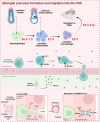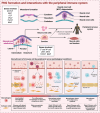Contemporary insights into neuroimmune interactions across development and aging
- PMID: 40786636
- PMCID: PMC12331649
- DOI: 10.3389/fneur.2025.1611124
Contemporary insights into neuroimmune interactions across development and aging
Abstract
Initially considered distinct systems with independent physiological functions, recent evidence highlights the crucial role of active crosstalk between the nervous and immune systems in regulating critical physiological and neurological processes and immunological homeostasis. The identification of a direct body-brain circuitry allowing the monitoring of peripheral inflammatory responses, a unique skull bone marrow source of immune cells to the central nervous system (CNS), and the physical interface of the blood-brain barrier with the meningeal system suggest direct intersystem interactions, which can be further modulated by the local tissue environment, allowing non-neurological factors to influence neurological outcomes and vice versa. While there is a recognized age-dependent decline in both neurological and immune system function, in part due to the natural accumulation of cellular defects and the development of chronic systemic inflammation, it is unclear if the pre-existing bidirectional feedback mechanisms between the neurological and peripheral immune system plays a role in shaping the system decline, beyond commonly investigated pathological conditions. In this review, we will explore the effect of aging on the bidirectional communication between the neurological and immunological systems and attempt to understand how the inevitable age-dependent alterations of the interaction may concurrently drive immunosenescence, normal neurological decline, and neuropathological progression.
Keywords: aging; immunosenescence; neurodegeneration; neuroimmune crosstalk; neurological decline.
Copyright © 2025 Yeo, Choi, Hong, Kwon and Jung.
Conflict of interest statement
The authors declare that the research was conducted in the absence of any commercial or financial relationships that could be construed as a potential conflict of interest. The author(s) declared that they were an editorial board member of Frontiers, at the time of submission. This had no impact on the peer review process and the final decision.
Figures



Similar articles
-
Morphological, functional and neurological outcomes of craniectomy versus cranial vault remodeling for isolated nonsyndromic synostosis of the sagittal suture: a systematic review.JBI Database System Rev Implement Rep. 2015 Sep;13(9):309-68. doi: 10.11124/jbisrir-2015-2470. JBI Database System Rev Implement Rep. 2015. PMID: 26470674
-
[Volume and health outcomes: evidence from systematic reviews and from evaluation of Italian hospital data].Epidemiol Prev. 2013 Mar-Jun;37(2-3 Suppl 2):1-100. Epidemiol Prev. 2013. PMID: 23851286 Italian.
-
T-bet expressing Tr1 cells driven by dietary signals dominate the small intestinal immune landscape.bioRxiv [Preprint]. 2025 Jul 4:2025.06.30.662190. doi: 10.1101/2025.06.30.662190. bioRxiv. 2025. PMID: 40747421 Free PMC article. Preprint.
-
Systemic treatments for metastatic cutaneous melanoma.Cochrane Database Syst Rev. 2018 Feb 6;2(2):CD011123. doi: 10.1002/14651858.CD011123.pub2. Cochrane Database Syst Rev. 2018. PMID: 29405038 Free PMC article.
-
Uncommon Non-MS Demyelinating Disorders of the Central Nervous System.Curr Neurol Neurosci Rep. 2025 Jul 1;25(1):45. doi: 10.1007/s11910-025-01432-8. Curr Neurol Neurosci Rep. 2025. PMID: 40591029 Review.
References
-
- Kloc J. What Have We Learned From Centuries of Chasing Immortality? The New York Times (2025). Available online at: https://www.nytimes.com/2025/01/18/well/longevity-history.html (Accessed April 7, 2025).
Publication types
LinkOut - more resources
Full Text Sources

